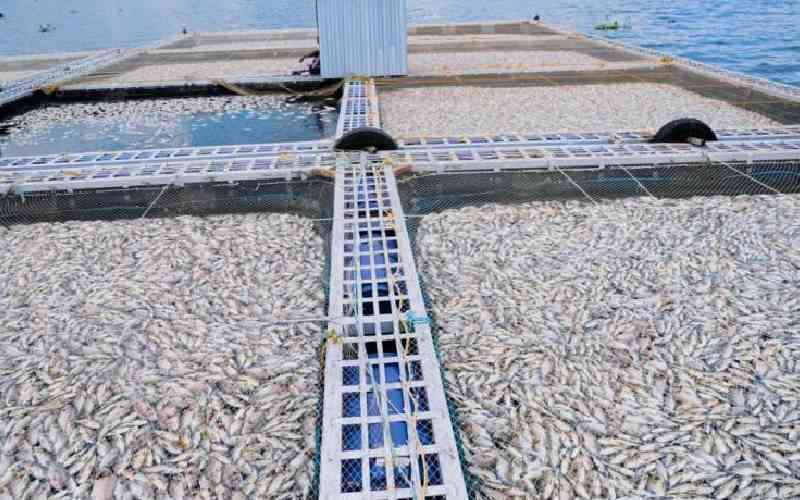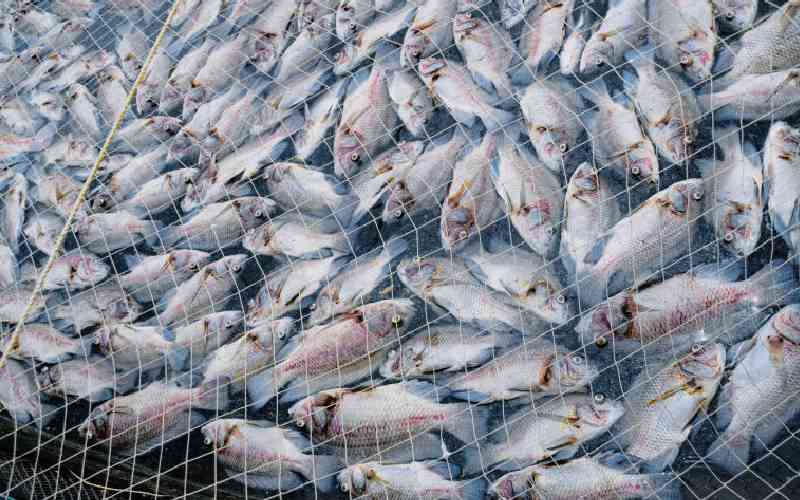
In the past month, massive fish kills have been reported in Kisumu and Homa Bay counties. Unlike in the past when fish in the lake died, the deaths occurred in cages.
In Homa Bay, cage farmers incurred losses in 90 cages comprising of 6,000 fish in each cage, translating to Sh108,000,000. In Kisumu, three sub-counties - Kisumu East, Kisumu West and Seme were affected with Othany beach (Seme) reporting about Sh40 million loss.
Interestingly, this occurrence is accompanied by a foul smell from the water whose colour has turned green, thus compromising the health of the riparian communities who use it for domestic purposes. To find a sustainable remedy to this challenge, we need to understand its root cause by answering a few questions. Is this phenomenon new? What is/are the cause/s? What is the way forward?
The first massive fish kills ever reported in Lake Victoria occurred in 1990. Both Nile tilapia and Nile perch were affected, with over 400,000 individual fish kills witnessed totaling to 2,400 tonnes, accounting for a loss of Sh1 billion at the current market value. An expansive area of 100km along the shores of Winam Gulf was affected.
The deaths were associated with algal blooms, a condition of massive production of algae as a result of high levels of nutrients, mainly nitrogen and phosphorus (eutrophication). The sources of nutrients included both point and non-point sources like storm water, agricultural run-off, industrial and wastewater effluent, faulty sceptic systems and lawn fertilisers from the catchments.
Eutrophication led to algal blooms covering the surface of the water thus inhibiting the penetration of light into the system. This hindered the aquatic plants from manufacturing their own food via photosynthesis to produce dissolved oxygen (DO). This led to low levels of DO, resulting into fish kills. Equally, the dying of algal blooms used oxygen to decompose.

Upwelling could also have compounded the situation. Here, the bottom cold water mixes with the top warm oxygenated water. During this process, the particles of dead algae, disturbed mud, and sediments clogged fish gills and prevented them from breathing. Additionally, the death decomposing macrophytes mainly of the water hyacinth and hippo grass settled at the bottom of the lake may have been re-suspended and utilised any remaining DO for further decomposition.
Whatever has happened in the lake in the past few months where we saw massive fish kills, it is not different from the above scenario. In both instances, the challenge faced is due to high level of pollution exacerbated by increased anthropogenic activities in the catchments.
However, there is one anthropogenic activity that has been taken right into the centre of the lake and is behind the challenges we are witnessing, but is not given attention at all. This is the cage culture that is estimated to produce about 12,000 tonnes of fish per production cycle (of eight months).
In fact, its effects are dire compared to the benefits. The waste from food given to fish and fish defecation is enormous, adding a lot of nitrogen and phosphorous. This exacerbates eutrophication hence proliferation of algal blooms. Fish cannot consume all the given feeds with more than 75 per cent of it going into waste.
Further, less than 30 per cent are digested and absorbed by fish for metabolic activities with the rest being excreted into water. For every tonne of tilapia production in cage culture, 11,041kg of organic matter are discharged into the water. Out of this, 45kg of nitrogen and 14 kg of phosphorous are produced.

In Lake Victoria, this translates into 12,487,560kg of organic matter. With this, fish kills are inevitable. No wonder, this occurred in cages only.
With this scenario in Lake Victoria ecosystem, the problem didn't begin yesterday, it has taken a while, only that it is becoming complex by each day. It may take many years to reverse the state of environment once the management interventions are undertaken because polluting an environment is faster than restoring it.
-Mr Kobingi is a PhD student of Limnology at Kisii University and a Research Scientist, KMFRI, Baringo Station. [email protected]
 The Standard Group Plc is a multi-media organization with investments in media
platforms spanning newspaper print
operations, television, radio broadcasting, digital and online services. The
Standard Group is recognized as a
leading multi-media house in Kenya with a key influence in matters of national and
international interest.
The Standard Group Plc is a multi-media organization with investments in media
platforms spanning newspaper print
operations, television, radio broadcasting, digital and online services. The
Standard Group is recognized as a
leading multi-media house in Kenya with a key influence in matters of national and
international interest.
